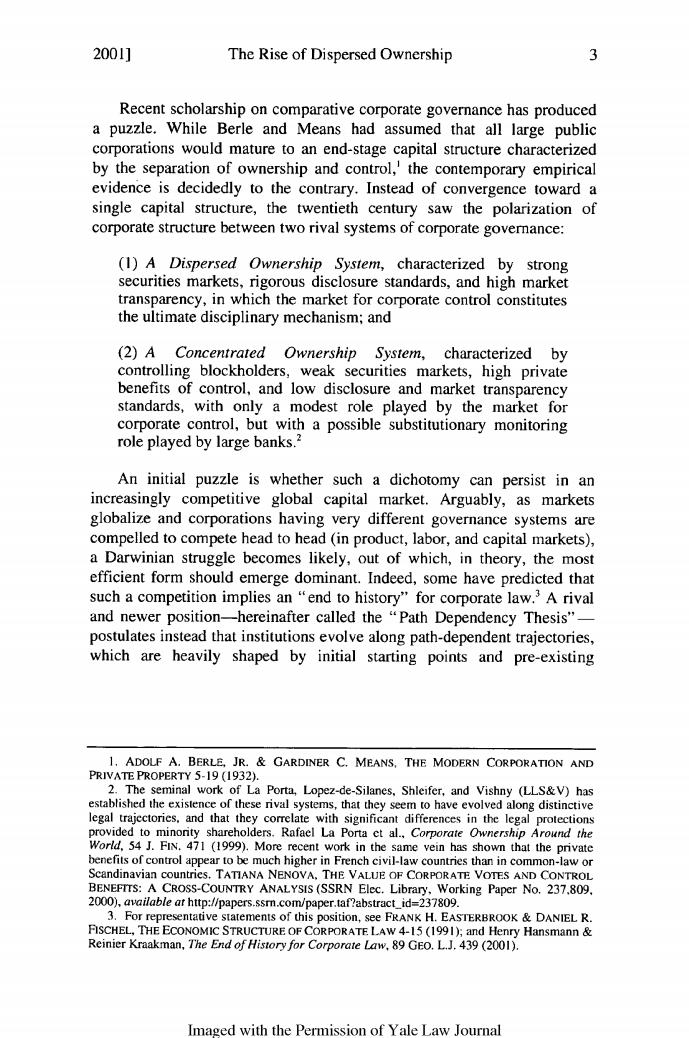正在加载图片...

20011 The Rise of Dispersed Ownership 3 Recent scholarship on comparative corporate governance has produced a puzzle.While Berle and Means had assum d that all large public corporations would mature to an end-stage capital structure characterized by the separation of ownership and control,'the contemporary empirical evidence is decidedly to the contrary.Instead of convergence toward a single capital structure,the twentieth century saw the polarization of corporate structure between two rival systems of corporate govemance: (1)A Dispe rsed Ownership System,characterized by strong securities markets rigorous disclosure standards,and high market transparency,in which the market for corporate control constitutes the ultimate disciplinary mechanism;and (2)A Concentrated Ownership System,characterized by controlling blockholders,weak securities markets,high private benefits of control,and low disclosure and market transparency standards,with only a modest role played by the market for corporate control,but with a possible substitutionary monitoring role played by large banks. An initial puzzle is whether such a dichotomy can persist in an increasingly competitive global capital market.Arguably, as markets s having very differen governance systems an compelled to compete head to head(in product,labor,and capital markets), a Darwinian struggle becomes likely,out of which,in theory,the most efficient form should emerge dominant.Indeed,some have predicted that such a competition implies an"end to hist fo corporate law.3Ar and newer position- -hereinafter called the "Path Dependency Thesis" postulates instead that institutions evolve along path-dependent trajectories, which are heavily shaped by initial starting points and pre-existing PRI ADOLF A.BERLE JR.&GARDINER C.MEANS.THE MODERN CORPORATION AND eminal work of La Porta.Lopez-de-Silan es.Shleifer.and Vishny (LLS&V)has and that syst that o have na119 hold Rafael La Porta he p CROSS- LUE OF CORP )hutp://papers.ssm.co /paper.taf?ab FISCHEL.THE ECO Reinier Kraakman The e End of History for Corporate Law,89 GEO.L.439() Imaged with the permission of Yale law lournal The Rise of Dispersed Ownership Recent scholarship on comparative corporate governance has produced a puzzle. While Berle and Means had assumed that all large public corporations would mature to an end-stage capital structure characterized by the separation of ownership and control,' the contemporary empirical evidence is decidedly to the contrary. Instead of convergence toward a single capital structure, the twentieth century saw the polarization of corporate structure between two rival systems of corporate governance: (1) A Dispersed Ownership System, characterized by strong securities markets, rigorous disclosure standards, and high market transparency, in which the market for corporate control constitutes the ultimate disciplinary mechanism; and (2) A Concentrated Ownership System, characterized by controlling blockholders, weak securities markets, high private benefits of control, and low disclosure and market transparency standards, with only a modest role played by the market for corporate control, but with a possible substitutionary monitoring role played by large banks.2 An initial puzzle is whether such a dichotomy can persist in an increasingly competitive global capital market. Arguably, as markets globalize and corporations having very different governance systems are compelled to compete head to head (in product, labor, and capital markets), a Darwinian struggle becomes likely, out of which, in theory, the most efficient form should emerge dominant. Indeed, some have predicted that such a competition implies an "end to history" for corporate law.3 A rival and newer position-hereinafter called the "Path Dependency Thesis"- postulates instead that institutions evolve along path-dependent trajectories, which are heavily shaped by initial starting points and pre-existing 1. ADOLF A. BERLE, JR. & GARDINER C. MEANS, THE MODERN CORPORATION AND PRIVATE PROPERTY 5-19 (1932). 2. The seminal work of La Porta, Lopez-de-Silanes, Shleifer, and Vishny (LLS&V) has established the existence of these rival systems, that they seem to have evolved along distinctive legal trajectories, and that they correlate with significant differences in the legal protections provided to minority shareholders. Rafael La Porta et al., Corporate Ownership Around the World, 54 J. FIN. 471 (1999). More recent work in the same vein has shown that the private benefits of control appear to be much higher in French civil-law countries than in common-law or Scandinavian countries. TATIANA NENOVA, THE VALUE OF CORPORATE VOTES AND CONTROL BENEFITS: A CROSS-COUNTRY ANALYSIS (SSRN Elec. Library, Working Paper No. 237,809, 2000), available at http://papers.ssrn.com/paper.taf?abstract-id=237809. 3. For representative statements of this position, see FRANK H. EASTERBROOK & DANIEL R. FISCHEL, THE ECONOMIC STRUCTURE OF CORPORATE LAW 4-15 (1991); and Henry Hansmann & Reinier Kraakman, The End of History for Corporate Law, 89 GEO. L.J. 439 (2001). Imaged with the Permission of Yale Law Journal 2001]